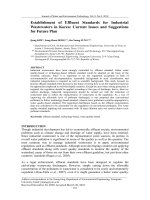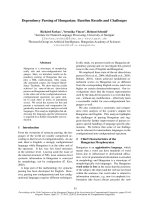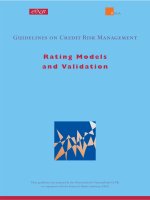RISK MANAGEMENT – CURRENT ISSUES AND CHALLENGES potx
Bạn đang xem bản rút gọn của tài liệu. Xem và tải ngay bản đầy đủ của tài liệu tại đây (15.84 MB, 595 trang )
CHALLENGES
Edited by Nerija Banaitiene
RISK MANAGEMENT
CURRENT ISSUES
AND
RISK MANAGEMENT –
CURRENT ISSUES AND
CHALLENGES
Edited by Nerija Banaitiene
Risk Management – Current Issues and Challenges
Edited by Nerija Banaitiene
Contributors
Werner Hürlimann, Rossella Agliardi, Petar Popivanov, Angela Slavova, A. Gonen, Sabrina
Grimaldi, Carlo Rafele, Anna Corinna Cagliano, Pako Thupayagale, Marius Ioan Podean, Dan
Benta, Robert Elliott Allinson, Daniel Ekwall, Omar Gaci, Hervé Mathieu, Jean-Pierre Deutsch,
Laurent Gomez, David R. Comings, Wendy W. Ting, Gabriela Dobrotă, Emilia Vasile, Ion
Croitoru, Óscar Lázaro, Agustín Moyano, Mikel Uriarte, Alicia González, Teresa Meneu, Juan
Carlos Fernández-Llatas, Vicente Traver, Benjamín Molina, Carlos Palau, Óscar López, Etxahun
Sánchez, Saioa Ros, Antonio Moreno, María González, José Antonio Palazón, Miguel Sepulcre,
Javier Gozálvez, Luis Collantes, Gonzalo Prieto, Amparo Marin de la Barcena, Marin Andreica,
Stere Farmache, Madalina Ecaterina Andreica, Octavian Stroie, Gurudeo Anand Tularam, Gowri
Sameera Attili, Jordi Botet, Pedro Maria-Sanchez, Nerija Banaitiene, Audrius Banaitis, Satit
Aditto, Christopher Gan, Gilbert V. Nartea, R. Martínez, D. Hemming, L. Malone, N. Bermudez,
G. Cockfield, A. Diongue, J. Hansen, A. Hildebrand, K. Ingram, G. Jakeman, M. Kadi,
G. R. McGregor, S. Mushtaq, P. Rao, R. Pulwarty, O. Ndiaye, G. Srinivasan, Eh. Seck, N. White,
R. Zougmoré, Á.G. Muñoz, D. Ruiz, P. Ramírez, G. León, J. Quintana, A. Bonilla, W. Torres,
M. Pastén, O. Sánchez, Andrew Charles, Yuriy Kuleshov, David Jones
Published by InTech
Janeza Trdine 9, 51000 Rijeka, Croatia
Copyright © 2012 InTech
All chapters are Open Access distributed under the Creative Commons Attribution 3.0 license,
which allows users to download, copy and build upon published articles even for commercial
purposes, as long as the author and publisher are properly credited, which ensures maximum
dissemination and a wider impact of our publications. After this work has been published by
InTech, authors have the right to republish it, in whole or part, in any publication of which they
are the author, and to make other personal use of the work. Any republication, referencing or
personal use of the work must explicitly identify the original source.
Notice
Statements and opinions expressed in the chapters are these of the individual contributors and
not necessarily those of the editors or publisher. No responsibility is accepted for the accuracy
of information contained in the published chapters. The publisher assumes no responsibility for
any damage or injury to persons or property arising out of the use of any materials,
instructions, methods or ideas contained in the book.
Publishing Process Manager Mirna Cvijic
Typesetting InTech Prepress, Novi Sad
Cover InTech Design Team
First published September, 2012
Printed in Croatia
A free online edition of this book is available at www.intechopen.com
Additional hard copies can be obtained from
Risk Management – Current Issues and Challenges, Edited by Nerija Banaitiene
p. cm.
ISBN 978-953-51-0747-7
Contents
Preface IX
Section 1 Approaches and Models for Risk Management 1
Chapter 1 Biometric Solvency Risk for Portfolios of General
Life Contracts (II) The Markov Chain Approach 3
Werner Hürlimann
Chapter 2 Boundary-Value Problems for Second Order
PDEs Arising in Risk Management and
Cellular Neural Networks Approach 31
Rossella Agliardi, Petar Popivanov and Angela Slavova
Chapter 3 Selecting a Response Plan Under Budget Constraints 55
A. Gonen
Chapter 4 A Framework to Select Techniques
Supporting Project Risk Management 67
Sabrina Grimaldi, Carlo Rafele and Anna Corinna Cagliano
Chapter 5 Long Memory in the Volatility
of Local Currency Bond Markets: Evidence
from Hong Kong, Mexico and South Africa 97
Pako Thupayagale
Chapter 6 Risk Management in Collaborative Systems 115
Marius Ioan Podean and Dan Benta
Chapter 7 On the Very Idea of Risk Management:
Lessons from the Space Shuttle Challenger 133
Robert Elliott Allinson
Section 2 Risk and Supply Chain Management 155
Chapter 8 Supply Chain Security – Threats and Solutions 157
Daniel Ekwall
VI Contents
Chapter 9 Dynamic Risk Management Strategies
with Communicating Objects in the Supply Chain
of Chemical Substances Within the European Union 185
Omar Gaci, Hervé Mathieu,
Jean-Pierre Deutsch and Laurent Gomez
Section 3 Enterprise Risk Management 203
Chapter 10 IA OM
®
as an Enterprise Risk Management Metric 205
David R. Comings and Wendy W. Ting
Chapter 11 Risk Management in Business – The Foundation
of Performance in Economic Organizations 227
Gabriela Dobrotă
Chapter 12 Integrated Risk Management System – Key Factor
of the Management System of the Organization 253
Emilia Vasile and Ion Croitoru
Chapter 13 Integrated and Personalised
Risk Management in the Sensing Enterprise 285
Óscar Lázaro, Agustín Moyano, Mikel Uriarte, Alicia González,
Teresa Meneu, Juan Carlos Fernández-Llatas, Vicente Traver,
Benjamín Molina, Carlos Palau, Óscar López, Etxahun Sánchez,
Saioa Ros, Antonio Moreno, María González, José Antonio
Palazón, Miguel Sepulcre, Javier Gozálvez,
Luis Collantes and Gonzalo Prieto
Section 4 Risk Management Practice
Across Different Projects and Industries 313
Chapter 14 Strengthening Risk Management
in the Midst of Downturn Times 315
Amparo Marin de la Barcena
Chapter 15 Risk Management on the Romanian Capital Market 329
Marin Andreica, Stere Farmache,
Madalina Ecaterina Andreica and Octavian Stroie
Chapter 16 Importance of Risk Analysis and Management –
The Case of Australian Real Estate Market 357
Gurudeo Anand Tularam and Gowri Sameera Attili
Chapter 17 Quality Risk Analysis:
Value for Money in the Pharmaceutical Industry 387
Jordi Botet
Contents VII
Chapter 18 Project and Enterprise Risk Management
at the California Department of Transportation 411
Pedro Maria-Sanchez
Chapter 19 Risk Management in Construction Projects 429
Nerija Banaitiene and Audrius Banaitis
Chapter 20 Sources of Risk and Risk Management
Strategies: The Case of Smallholder Farmers
in a Developing Economy 449
Satit Aditto, Christopher Gan and Gilbert V. Nartea
Section 5 Climate Risk Management 475
Chapter 21 Improving Climate Risk Management at Local Level –
Techniques, Case Studies, Good Practices and Guidelines
for World Meteorological Organization Members 477
R. Martínez, D. Hemming, L. Malone, N. Bermudez, G. Cockfield,
A. Diongue, J. Hansen, A. Hildebrand, K. Ingram, G. Jakeman,
M. Kadi, G. R. McGregor, S. Mushtaq, P. Rao, R. Pulwarty,
O. Ndiaye, G. Srinivasan, Eh. Seck, N. White and R. Zougmoré
Chapter 22 Risk Management at the Latin American Observatory 533
Á.G. Muñoz, D. Ruiz, P. Ramírez, G. León, J. Quintana,
A. Bonilla, W. Torres, M. Pastén and O. Sánchez
Chapter 23 Managing Climate Risk with Seasonal Forecasts 557
Andrew Charles, Yuriy Kuleshov and David Jones
Preface
Companies face risks every day, they are part of normal business life. There are many
risks — both threats and opportunities — which may impact on a company‘s
resources, projects and profitability. Risk means different things to different businesses
and organizations. Undoubtedly, the risk represents both a potential threat and
potential opportunity for businesses.
Every business and decision involves a certain amount of risk. Risk might cause a loss
to a company. This does not mean, however, that businesses cannot take risks. As
disengagement and risk aversion may result in missed business opportunities, which
will lead to slower growth and reduced prosperity of a company. In today‘s
increasingly complex and diverse environment, it is crucial to find the right balance
between risk aversion and risk taking. To do this it is essential to understand the
complex, out of the whole range of economic, technical, operational, environmental
and social risks associated with the company’s activities. However, risk management
is about much more than merely avoiding or successfully deriving benefit from
opportunities. Risk management is the identification, assessment, and prioritization of
risks. Lastly, risk management helps a company to handle the risks associated with a
rapidly changing business environment. When risk management does receive
attention, it is often in response to unforeseen (and usually negative) events.
The impact of the global economic crisis has varied from one country to another: not
all countries, sectors and organizations were affected in the same hard way by it. Even,
the impact of the financial crisis is varying widely across companies within the same
sector. In today’s post-crisis economy effective risk management is a critical
component of any successful management strategy. In complex and rapidly changing
situations, as today’s supply chains and partnership arrangements tend to be,
management needs to consider all risks within the enlarged business connections.
Understanding of the risk management is vital for both practitioners and researchers.
The emergence of new insights into approaches and models can help address
multifaceted risk management issues.
There are five parts in this book of 23 chapters. The papers are organized according to
theoretical, methodological and practical issues and areas of risk management: Part 1
X Preface
provides new insights into theoretical approaches and models for risk management,
Part 2 deals with risk and supply chain management, Part 3 focuses on specific aspects
of enterprise risk management, Part 4 examines risk management practice across
different projects and industries, and Part 5 discusses emerging issues related to
climate change and climate risk management. The authors touched on a wide range of
risk management issues. Consequently, in the context of the thematic classification
scheme, some papers fall into more than one category.
I consider it an honour and privilege to have had the opportunity to edit this book. I
am particularly grateful to all the authors for their outstanding contributions, and to
Mirna Cvijic, the publishing process manager at InTech, for her kind assistance in
publishing this book.
Dr. Nerija Banaitiene
Department of Construction Economics and Property Management,
Faculty of Civil Engineering,
Vilnius Gediminas Technical University,
Lithuania
Section 1
Approaches and Models for Risk Management
Chapter 1
Biometric Solvency Risk for Portfolios of General
Life Contracts (II) The Markov Chain Approach
Werner Hürlimann
Additional information is available at the end of the chapter
1. Introduction
The main theoretical goal of the present exposé is to extend the results presented in
Hürlimann [1] to the Markov chain model of life insurance, which enables modeling all
single life/multiple life traditional contracts subject to biometric risk with multiple causes of
decrement. In particular, a complete risk modeling of single-life insurance products with
mortality and disability risks requires the specification of a Markov model with three states.
As novel illustration we offer to the interested practitioner an in-depth treatment of
endowment contracts with waiver of premium by disability.
The present investigation is restricted to biometric risks encountered in traditional insurance
contracts within a discrete time Markov chain model. The current standard requirements for
the Solvency II life risk module have been specified in QIS5 [2], pp.147-163. QIS5 prescribes
a solvency capital requirement (SCR), which only depends on the time of valuation (=time at
which solvency is ascertained) but not on the portfolio size (=number of policies). It accounts
explicitly for the uncertainty in both trends (=systematic risk) and parameters (=parameter
risk) but not for the random fluctuations around frequency and severity of claims (=process
risk). In fact, the process risk has been disregarded as not significant enough, and, in order
to simplify the standard formula, it has been included in the systematic/parameter risk
component. For the purpose of internal models and improved risk management, it appears
important to capture separately or simultaneously all risk components of biometric risks. A
more detailed account of our contribution follows.
As starting point, we recall in Section 2 the general solvency rule for the prospective liability
risk derived in [1], Section 2, which has resulted in two simple liability VaR & CVaR target
capital requirements. In both stochastic models, the target capital can be decomposed into a
solvency capital component (liability risk of the current period) and a risk margin
component (liability risk of future periods), where the latter must be included (besides the
Risk Management – Current Issues and Challenges
4
best estimate liabilities) in the technical provisions. This general decomposition is in
agreement with the current QIS5 specification. The proposed approach is then applied to
determine the biometric solvency risk capital for a portfolio of general traditional life
contracts within the Markov chain model of life insurance. For this, we assume that the best
estimate liabilities of a general life contract coincide with the so-called “net premium
reserves”. After introduction of the Markov chain approach to life insurance in Section 3, we
recall in Section 4 the ubiquitous backward recursive actuarial reserve formula and the
theorem of Hattendorff. Based on this we determine in Section 5 the conditional mean and
variance of a portfolio’s prospective liability risk (=random present value of future cash-
flows at a given time of valuation) and use a gamma distribution approximation to obtain
the liability VaR & CVaR solvency capital as well as corresponding solvency capital ratios.
These first formulas include only the process risk and not the systematic risk. To include the
latter risk in solvency investigations we propose either to shift the biometric transition
probabilities, as done in Section 6.2, or apply a stochastic model, which allows for random
biometric transition probabilities, as explained in Section 6.3. Section 7 illustrates
numerically and graphically the considered VaR & CVaR solvency capital models for a
cohort of endowment contracts with waiver of premium by disability and compares them
with the current Solvency II standard approach. Finally, Section 8 summarizes, concludes
and provides an outlook for possible alternatives and extensions.
2. A general prospective approach to the liability risk solvency capital
Starting point is a multi-period discrete time stochastic model of insurance. Given is a time
horizon
T and a probability space
,
,FP endowed with a filtration
0
T
t
t
F
such that
0
,
F
and
T
FF
. Let
t
LF
be the space of essentially bounded random variables
on
,
,FP and
B
the space of essentially bounded stochastic processes on
,
,FP
which are adapted to the filtration
0
T
t
t
F
. The basic discrete time stochastic processes are
,
tt
A
L : the assets and actuarial liabilities at time t
In a total balance sheet approach, their values depend upon the stochastic processes in
B
,
which describe the random cash-in and cash-out flows of any type of insurance business:
1t
P
: loaded premiums to be paid at time 1t
(assumed invested at time 1t
)
t
X : insurance costs to be paid at time t (includes insurance benefits, expenses and bonus
payments paid during the time period
1,tt
)
t
R : accumulation factor for return on investment for the time period
1,tt
We assume that
t
X is
t
F -measurable and
t
R is
1t
F
-measurable. The random cumulated
accumulation factor for return over the period
,
,0 ,st s t T
is denoted by
,
1
t
st j
js
RR
.
Since
t
R is
1t
F
-measurable
,
st
R
is
1t
F
-measurable, and therefore
,
,
st
Rts is a
Biometric Solvency Risk for Portfolios of General Life Contracts (II) The Markov Chain Approach
5
predictable stochastic process. The quantity
1
,
,st st
DR
is called random discount rate.
Consider the
1tj
F
-measurable discrete time stochastic process
,
0,1, , 1
tj
CF j T t
of
future insurance cash-flows defined by
,1 1
0,1, , 1.
tj tjtj tj tj
CF D X P j T t
(1)
The actuarial liabilities at time
t , also called time- t prospective insurance liability, coincide
with the random present value of all future insurance cash-flows at time
t given by
1
,
0
,
0,1, , 1.
Tt
t ttj tj
j
LDCFt T
(2)
Using (1)-(2) and the relationship
,
1,11,1tt k tt t t k
DDD
, one obtains the recursive
equation
111
,
1, , 1
ttttt
LLPRXt T
. On the other hand, the random assets over
the time horizon
0,T
satisfy by definition the recursive equation
111
,
1, , 1
ttttt
AAPRXt T
. Through subtraction it follows that
11 1
(),1, ,1,
tt ttt
AL ALR t T
(3)
which implies the following equivalent probabilistic conditions (use that trivially 0
T
L )
01,
Tt
PA F
(4)
,1,2, , 1 1,
tt t
PA L T t F
(5)
1.
ttt
PA LF
(6)
Given a default probability 0
, the liability VaR solvency criterion (6) says that at time t the
initial (deterministic) capital requirement
t
A
should exceed the random present value of
future cash-flows with a probability of at least 1
. By (4)-(5) this criterion automatically
implies that assets will exceed liabilities with the same probability at each future time over
the time horizon
T . Let
1
VaR
ttt
AVaRLF
be a minimum solution to (6), and assume
that the best estimate insurance liabilities at time
t coincide with the net premium reserves (in
the sense defined later in (35), that is let
Z
tt t
ELF V
. Then, the liability VaR solvency capital
1
VaR VaR Z Z
ttt ttt
SC A V VaR L F V
represents the capital available at time t to meet
the insurance risk liabilities with high probability. A
risk margin is added to this capital
requirement (recall that in Solvency II the sum of the best estimate insurance liabilities and
the risk margin determines the Technical Provisions). The
liability VaR target capital is the
sum of the liability VaR solvency capital and the risk margin defined by
.
VaR VaR VaR
tt t
TC SC RM (7)
Risk Management – Current Issues and Challenges
6
The cost-of-capital risk margin with cost-of-capital rate 6%
CoC
i is defined by
1
,
Tt
VaR k VaR
tCoC ftk
k
RM i v SC
(8)
where
T denotes the time horizon, and
f
v
is the risk-free discount rate. For comparison
with other solvency rules, one considers the
VaR solvency capital ratio at time
t
defined by
/
.
VaR VaR Z
ttt
SR SC V
(9)
Alternatively, let
11
,
tt t t tt t
CVaR L F E L L VaR L F F
be the conditional value-at-
risk of the random present value of future cash-flows at the confidence level 1
given the
information available at time
t . The liability CVaR target capital
1
CVaR Z CVaR CVaR CVaR
ttttttt
TC CVaR L F V RM SC RM
also meets the insurance risk
liabilities and it defines the CVaR solvency capital ratio at time
t :
/
.
CVaR CVaR Z
ttt
SR SC V
(10)
3. The Markov chain approach to general life contracts
Consider the Markov chain model of a general life insurance (GLIFE) contract with state space
S and arbitrary payments. The state space S is the finite set of states a contract can be during
its lifetime. Payments are induced by two kinds of events:
Type 1: payments induced by being in a certain state
Type 2: payments induced by a jump of state
The payment function vector of a contract at time
0,1,2, k
is expressed as a vector
() (), ()
iij
ak a k a k i j S, where the payment functions are defined by
Type 1: ( ),
i
ak i S , is the payment if the contract at time k is in state i .
Type 2:
(), , 1
ij
aki jSk
, is the payment if the contract was in state i at time 1k and is
in state state
j at time k . For convenience set
(0) 0
ij
a
for ijS
and
() 0
ij
ak
for
ijS .
For better interpretation one splits the payment ( )
i
ak into a benefit part and a premium part
such that () () (), , 0,1,2,
iii
ak bk k i Sk
, where ( ) 0
i
k
denotes the non-negative
premium paid at time k when the contract is in state i . Note that in most applications one
has ( ) 0
i
k
if the state i is different from the state of being “active” (premiums are only
paid in this situation). Restricting the attention to biometric risk only, we assume
throughout a flat term structure of interest rates with annual interest rate i and discount
factor
1/(1 )vi
. The state of a GLIFE contract over time is described by the discrete time
Biometric Solvency Risk for Portfolios of General Life Contracts (II) The Markov Chain Approach
7
stochastic process
0,1,2,
k
k
X
with values in S . The event
k
Xs
means that the contract
at time k is in state
s . We assume that
0,1,2,
k
k
X
is a Markov chain, which implies that the
joint distributions of the random states can be represented in terms of the
one-step transition
probability matrix
,
()
ij
ij S
pk p k
, which is defined by
1
, 0,1,2,
ij k k
pk PX jX i k
(11)
The set
,
( ), , 0,1,2,
k
Sak X k defines the Markov chain model widely discussed in life
insurance (Amsler [3]; Hoem [4], [5]; Koller [6]; Milbrodt & Helbig [7]; Wolthuis [8]; etc.).
Now, using the indicator function
()I
, consider the random cash-flow of the GLIFE contract
in year
,
1kk
valued at time
0,1,2, k
, which is defined by
1
() () ( 1) .
kii k ij kk
iS i jS
CbkkIXivakIXiXj
(12)
The insurance loss random variable of a GLIFE contract is defined by
0
.
k
k
k
LvC
(13)
This identifies the insurance loss with the random present value of all future cash-flows.
Furthermore, for an arbitrary non-negative integer 0,1,
, one defines the time-
prospective loss random variable
1,
k
k
k
LivC
(14)
whose (conditional) expected value defines the time-
actuarial reserve
,
.
kk
kS
VELX V V ELXk
(15)
The quantity
k
V
is called state- k time-
actuarial reserve. In particular, one has
0
LL and
0
VEL
is the initial actuarial reserve, which is not assumed to vanish.
4. Backward recursive reserve formula and the theorem of Hattendorff
In a first step, we derive a recursion formula for the actuarial reserves. Recall the recursion
formula for the random prospective loss
1
.LCvL
(16)
Assume that the contract is in state . kS
at time
. Inserting (16) into (15) yields
Risk Management – Current Issues and Challenges
8
1
.
k
VECXkvELXk
(17)
Using (12) the first expectation in (17) can be rewritten as
1
(1) () ()
(1) () () ().
ij i i
ijS iS
kj kj k k
jkS
v a PX i X jX k b PX iX k
va p b
The second expectation equals
1111 1
().
j
kj
jS jS
EL X k EL X j PX jX k V p
Inserting both expressions into (17) and using the made convention ( 1) 0
kk
a
as well as
the relationship ( ) 1
kj
jS
p
, one obtains the backward recursive reserve formula
1
() ( 1) () ().
j
k
kj kj k k
jS
VpvVva b
(18)
The actuarial reserve at time
given the contract is in state kS
equals the one-year
discounted sum over all possible states of the
actuarial reserves at time 1
,
payments at time 1
due to a jump in states,
payments at time
due if being in a certain state,
which is weighted by the one-step transition probabilities and reduced by the premium paid
at time
when the contract is in state k . The representation (18) is a discrete version of
Thiele’s differential equation. Thiele's differential equation is a simple example of a
Kolmogorov backward equation, which is a basic tool for determining conditional expected
values in intensity-driven Markov processes, e.g. Norberg [9].
Let us rearrange (18) in order to obtain the Markov chain analogue of the classical
decomposition of the premium into risk premium and saving premium (Gerber [10], [11]),
Section 7.5, equation (5.3), and [1], equation (19).
Theorem 4.1 The premium ( )
k
at time
if the contract is in state kS
is the sum of a
saving premium
()
S
k
and a risk premium
()
R
k
, which are defined as follows:
1
()
Skk
k
vV V
(19)
11
() () () ( 1)
j
Rk
k k kj kj
jS
bvVvp a V
(20)
Biometric Solvency Risk for Portfolios of General Life Contracts (II) The Markov Chain Approach
9
Proof. Making use of the recursion (18) and the relationship ( ) 1
kj
jS
p
, one obtains
11 1
1
() () () () ( 1)
() ( 1) () (),
j
SR kk k
kk k kjkj
jS
j
k
kj kj k k
jS
vV V b vV v p a V
Vpva vVb
which shows the desired decomposition. ◊
The saving premium represents the expected change in actuarial reserve at time
for a
contract in state
k while the risk premium is the expected value at time
of a contract in
state
k needed to cover the insurance risk in time period
,
1
. Rewrite the latter as
11
() () () ( 1) .
j
Rk
k k kj kj
jS
bvp a VV
(21)
This is the sum of the benefit payment at time
for a contract in state k and the probability
weighted sum of the
sums at risk
11
(1)
j
k
kj
aVV
due to transitions from state k to
state
j at time 1
. The sum at risk is the amount credited to the insured’s contract upon a
transition, namely the lump sum payable immediately plus the adjustment of the actuarial
reserve. The obtained results constitute a discrete time version of those mentioned in
Norberg [12], p.10.
To evaluate the mean and variance of the random insurance loss (13) of a GLIFE contract,
we follow the martingale approach to the
Theorem of Hattendorff (Bühlmann [13]; Gerber [14];
Gerber et al. [15]; Hattendorff [16]; Kremer [17]; Patatriandafylou & Waters [18]; etc.). For
this consider the set of 1
contract states
,
0,1, ,SX
at time
and the
sequence of random variables
00
,
1,2, , .YELS YELV
(22)
The discrete time stochastic process
Y
is a martingale with respect to
S
. The
martingale differences
1
,
0,1,2, YYv
, represent the discounted one-year
insurance losses
and form a sequence of uncorrelated random variables such that
0
0
0, , 0, 0 , .ECov LVv
(23)
Through detailed calculation one obtains the following result.
Theorem 4.2 The variance of the random insurance loss of a GLIFE contract is determined
by the following formulas
2
0
,
Var L v Var C
(24)
Risk Management – Current Issues and Challenges
10
22
(), () (),
SS S
k
kS kS
Var C E C X k P X k
(25)
2
2
() ()
(1) () () (1) ().
kk
kj k k kj kj
jS
EC X k b
va b va p
(26)
Proof. Similarly to Gerber et al. [15], formula (89), one has
1
0
.
j
j
j
YvCvELS
(27)
Using (15) one obtains
111
11
(),
S
kS
vYYvCvELSELS
vC vEL X k ELX k vC
(28)
().
S
C
(29)
Since
0E
one gets ( )
S
EC
and further
2
22 2
(),
S
kS
Var Var C E C E C E C X k P X k
(30)
which is (25). To obtain (26) one uses (12) and the convention
(1)0
ii
a
to get
2
2
1
,
() ()
(1) () () (1) ,
ii
iS
ij i i ij
ij S
Cb IXi
va b va I X i X j
(31)
which implies that
2
2
() () ( 1) () () ( 1) ().
kk kj kk kj kj
jS
EC X k b va b va p
(32)
Remark 4.1 In the single life case, the variance formulas in Theorem 4.2 should be compared
with the ones for the GLIFE contract with one and multiple causes of decrement in [1],
formulas (24)-(26). One can ask if the formula (25) is equivalent to the following one (at least
in the single life case)
Biometric Solvency Risk for Portfolios of General Life Contracts (II) The Markov Chain Approach
11
2
22
11
(1) () () .
j
kR
kj kj k
kS jS
Var C a V V v p P X k
(33)
5. The liability VaR & CVaR solvency capital for portfolios of GLIFE
contracts
We begin with risk calculations for a single GLIFE contract, and use them to determine the
liability VaR & CVaR solvency capital for a portfolio of GLIFE contracts.
5.1. Risk calculations for a single GLIFE contract
Given is a single GLIFE contract with random future cash-flows
k
C defined by (12). We
assume that the state space contains a unique distinguished “void” state
k
X
meaning that the contract has terminated at time k . We assume contract survival, i.e. a
contract is still alive at time of valuation
t , which implies that the conditional event
tt
EX
is fulfilled. We note that the random present value of future cash-flows at
time
t defined by
0
,
0,1, ,
j
ttj
j
ZvCt
(34)
coincides with the time-
t prospective loss defined in (14), that is
,
0,1,
tt
ZLt .
Therefore, the expected value given contract survival equals
.
t
Zk k
ttt tttt
kS kS
t
PX k
VEZE VPXkE V
PE
(35)
In contrast to (15) the reserve defined in (35) is state independent and called net premium
reserve, see Bowers et al. [19], Chap.17.7, p. 500, for a special case. Following Section 2, this
value can been chosen as best estimate of the contract liabilities.
Remarks 5.1 (i) The motivation for state-independent reserves is second-to-die life
insurance, where during lifetime the insurer may not be informed about the first death. An
endowment with waiver of premium during disability, which is our illustration in Section 7,
seems to contradict this concept because it cannot be argued that the insurer is unaware of
the state occupied while the premium is being waived. However, at a given arbitrary time of
valuation (including starting dates of contracts) future states of contracts are unknown, and
therefore it is reasonable in a first step to assume state independent reserves for the design
of a general method. Later refinement might be necessary to cover all possible cases.
(ii) State independent reserves have been introduced by Frasier [20] for the last-survivor
status, see also The Actuary [21] and Margus [22]. The choice between state independent
and state dependent reserves depends upon loss recognition in the balance sheet
(recognition or not of a status change). With state independent reserves, the insurance
Risk Management – Current Issues and Challenges
12
company administers the contract as if it had no knowledge of any decrements, as long
as the contract is not terminated. Only the latter situation is considered in the present
work.
In a first step, we determine the mean and variance of the conditional distribution of
t
Z
given
t
E . Similarly to [1], Section 5.1, the variance formulas (24)-(26) generalize to an
arbitrary discrete time 1,2, t
. Formula (23) generalizes as
kt
tt t k
kt
LVIE v
. (36)
Noting further that
,
0,1,
tt
ZLt , one obtains from (36) the following conditional
variance formulas (conditional version of Theorem 4.2).
Theorem 5.1 The conditional variance is determined by the following formulas
2
2
22
2
00
22
2
2
()
,
()
,
() ()
()()
ttt
tt t t
t
SS
tttt t k
kS kS
tt k k
kj
EC PE EC
Var Z E v Var C E v
PE
EC EC X k PX k EC t t
EC X k b t t
va
(1)()()(1)().
k k kj kj
jS
tbttvatpt
(37)
As shown in the next Subsection, these formulas can be used to determine the target capital
and solvency capital ratio of a portfolio of GLIFE contracts using appropriate
approximations for the distribution of the random present value of future cash-flows
associated to this portfolio under the condition that the contracts are still alive.
5.2. Solvency capital and solvency capital ratio for a portfolio of GLIFE contracts
Towards the ultimate goal of solvency evaluation for an arbitrary life insurance portfolio,
we consider now a set of n policyholders alive at time
t
. From Section 3 one knows that the
i -th contract
1, ,in
is characterized by the following data elements:
contract duration
i
t at time t
state space
()i
S
states
()
0,1,2,
i
k
k
X
of the contract over time with values in
()i
S
condition for contract survival
() ()
ii
ii
tt
EX
at time
t
one-step transition probabilities
() () ()
1
,
0,1,2,
iii
rs k k
pkPX sX r k
, defining the
Markov chain model of the contract
Biometric Solvency Risk for Portfolios of General Life Contracts (II) The Markov Chain Approach
13
payment function vector
() () () ()
() (), ()
iii i
rrs
ak akakrsS of the contract at time
0,1,2, k with the two types of payment:
Type 1:
() ()
(),
ii
r
akrS , is the payment if the contract at time k is in state r .
Type 2:
() ()
(), , 1
ii
rs
akrsS k
, is the payment if the contract was in state r at time 1k
and is in state state s at time k
splitting
() () () ()
() () (), , 0,1,2,
ii i i
rr r
ak bk k rSk
into a benefit & premium part
To the i -th contract one associates its random future cash-flows
()i
k
C as defined in (12),
the corresponding
()
i
i
t
L time-
i
t random prospective loss (14) and time-
i
t net premium
reserve
,
() () ()
iii
Zi i i
ttt
VELE
obtained from (35). The random present value of future cash-
flows of the portfolio is obtained by summing (34) over all contracts and is given by
() ()
10 0 1
,
0,1, .
ii
nn
jj
ii
t
tj tj
ij j i
ZvCvCt
(38)
Similarly, summing the individual net premium reserves, one gets the
portfolio reserve
,
()
1
.
i
n
Zi
Z
t
t
i
VV
(39)
Following Section 2, one defines the
portfolio VaR solvency capital
()
1
,
1, , ,
i
i
VaR Z
tt t
t
SC VaR Z E i n V
(40)
as well as the
portfolio CVaR solvency capital
()
1
,
1, , ,
i
i
CVaR Z
tt t
t
SC CVaR Z E i n V
(41)
and the corresponding solvency capital ratios
/
,/.
VaR VaR Z CVaR CVaR Z
tttt tt
SR SC V SR SC V
(42)
To determine these quantities it is necessary to determine the distribution of
t
Z conditional
on contract survivals at time
t , and under the assumption that the remaining lifetimes of all
contracts are independent of each other. From Theorem 5.1 we have
() () ()
2
01
2
() () ()
2
2
()
2
01
, 1, , , , 1, ,
()()
,
()
ii i
iii
i
n
ii i
Z
ttt
tt t
i
iii
n
ttt
i
i
t
EZEi nV VarZEi n v VarC
EC PE EC
v
PE
(43)
Risk Management – Current Issues and Challenges
14
()
()
()
,( ) ,( )
() () () ()
22
2
() ()
2()()
() ()
() (),
() () ,
() () ()
(1)()
i
i
iiii
i
ii
i
Si Si
iki
t
kS
iiii
tttt
kS
ii
ii
ki ki
tt
ii
kj i k i
EC t t
EC EC X k PX k
EC X k b t t
va t b t
()
() () ()
() ( 1) ().
i
ii i
ki kji kji
jS
tvat pt
(44)
Based on the conditional mean and variance we approximate the distribution function of
t
Z
by a gamma distribution as in [1], Section 5. Denote this approximation by
()
() Pr , 1, ,
i
i
tt
t
Fx Z xE i n . Then, recalling the gamma distribution function, one has
1
22
0
111
() ( ; ) , , ,
()
t
t
x
t
ttt t t
t
ttt
Fx G x t e dt
kk
(45)
where
,
tt
k
are the conditional mean and coefficient of variation of
t
Z (obtained from (43)-
(44)). In this setting, the solvency capital ratio formulas (42) take the forms
22
1
1,
VaR
ttt
SR z k k
22
1
22
1
;
,
tt
CVaR
ttt
gz k k
SR z k k
(46)
where
1
1
(): (1 ;)zG
denotes the
(1 )
-quantile of the standardized gamma
(; )Gx
and (; ) '(; )
g
xGx
denotes its probability density. The limiting results for a
portfolio of infinitely growing size are similar to those in [1], Remark 5.1. If the coefficients
of variation tend to zero, the gamma distributions converge to normal distributions and the
solvency capital ratios converge to zero. This holds under the following assumption.
Whenever insured contracts are independent and identically distributed, and if the portfolio
size is large enough, then the ratio of observed state transitions to portfolio size is close to
the given rates of transition with high probability. This assumption is related to the process
risk, which describes the random fluctuations in the biometric transition probability matrix.
However, if the ratio of observed state transitions to portfolio size is not close to the given
rates of transition, even for large portfolio sizes, systematic risk exists, e.g. Olivieri & Pitacco
[23], Section 2.1. In this situation, the rates of transition are uncertain and assumed to be
random, and we consider stochastic models that include the process and systematic risk
components. This is the subject of Section 6.3.
6. Comparing the standard approach with variants of the stochastic
approach
Since the present Section has some overlap with [1], Section 6, it is treated more briefly, but
can be read independently. Facts peculiar to the Markov chain approach are added
whenever felt necessary. Recall that biometric risks in QIS5 accounts for the uncertainty in









